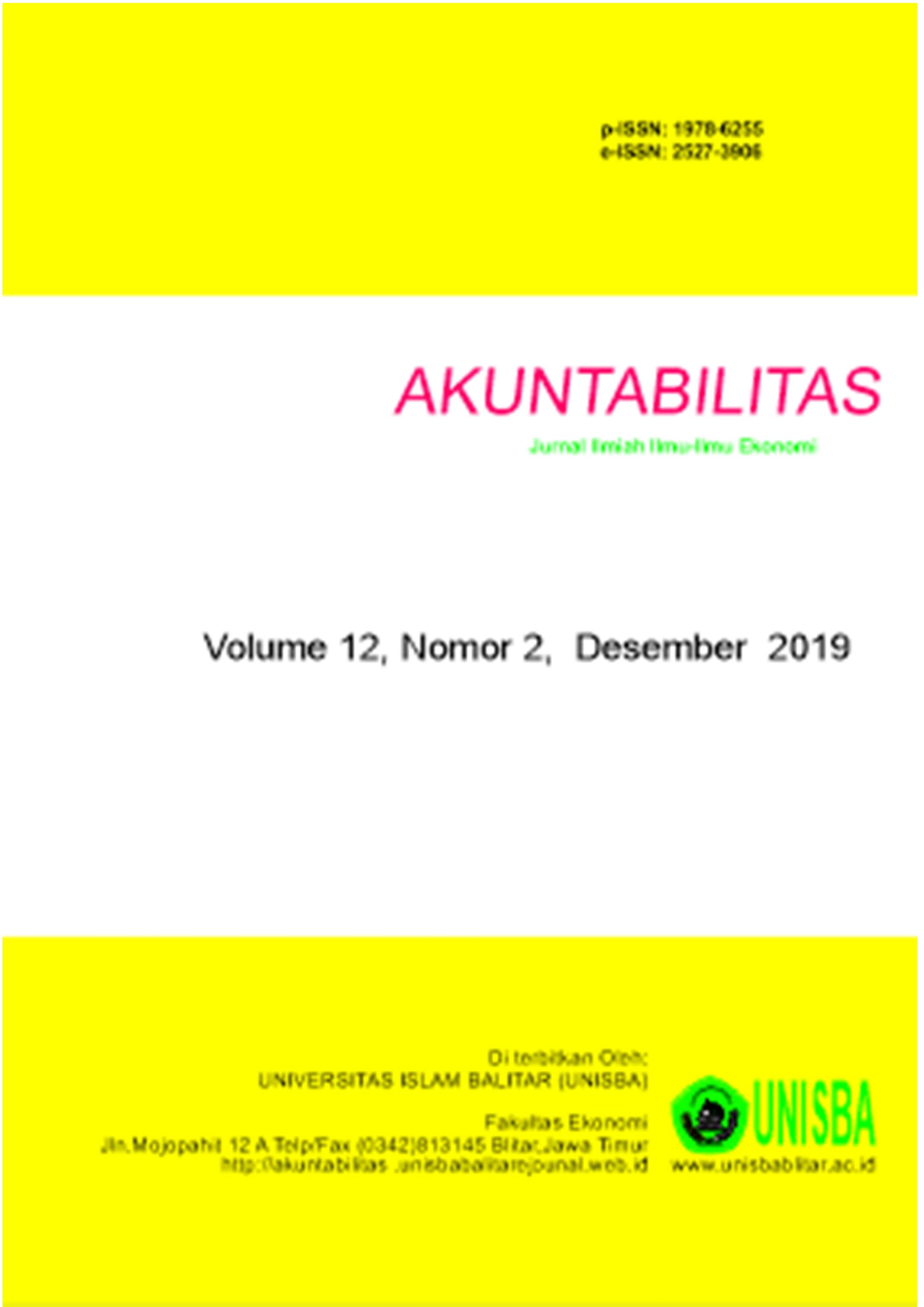ANALISIS PEER TO PEER LENDING DI INDONESIA
DOI:
https://doi.org/10.35457/akuntabilitas.v11i2.902Keywords:
peer to peer lending, financial technology, financing, SMEsAbstract
Problems arising from the development of fintech include data security and legal certainty of online-based loans so that it impacts on potential risks to consumers and financial stability and integrity. The purpose of this study is to analyze the development of peer to peer lending in Indonesia, which is reviewed based on relevant institutional regulations and literature studies. This research uses a descriptive method with literature review. The results of this study describe the types of fintech that fall into the dominant category in Indonesia are peer to peer lending, peer to peer lending users by productive age with a percentage of 70%. In October 2019 the number of loans increased 200.01%. The government supervises peer to peer lending through three institutions there are Bank Indonesia, the Ministry of Communication and Information and OJK. The three institutions oversee operations from the start up to consumer protection. Peer to peer lending targets MSMEs that are feasible but cannot obtain bank credit facilities. Peer to peer lending can help develop MSMEs in financial terms, especially in the field of financing.
Downloads
References
Anagnostopoulos, I. (2018). Fintech and Regtech: Impact on Regulators and Banks. Journal of Economics and Business. https://doi.org/10.1016/j.jeconbus.2018.07.003
Ansori, M. (2019). Perkembangan dan Dampak Financial Technology (FINTECH) Terhadap Industri Keuangan Syariah di Jawa Tengah. Wahana Islamika: Jurnal Studi Keislaman, 5(1), 31–45.
Basuki, F. H., & Husein, H. (2018). Analisis SWOT Financial Technology Pada dunia Perbankan di Kota Ambon. Manis, 2(1), 60–74.
Chrismastianto, I. A. W. (2017). Analisis SWOT Implementasi Teknologi Finansial Terhadap Kualitas Layanan Perbankan di Indonesia. Jurnal Ekonomi Dan Bisnis, 20(1), 133–144.
Darussalam, A. Z., Tutuko, B., Dahlan, A., Hudaifah, A., & Tajang, A. D. (2018). Islamic Financial Technology Towards The Advancement of Islamic Banking In Indonesa. Nisbah, 4(2), 171–181.
Dwinanda, A. R. D. (2019). Penerapan Prinsip Kehati-Hatian Dalam Layanan Pinjam Meminjam Uang Berbasis Teknologi Informasi Pada Situs Uangteman.com. Jurist-Diction, 2(3), 819–834.
Hedynata, M. L., & Radianto, W. E. D. (2016). STRATEGI PROMOSI DALAM MENINGKATKAN PENJUALAN LUSCIOUS CHOCOLATE POTATO SNACK. PERFORMA: Jurnal Manajemen Dan Start-Up Bisnis, 1(April).
Jagtiani, J., & Lemieux, C. (2018). Do Fintech Lenders Penetrate Areas That Are Underserved by Traditional Banks? Journal of Economics and Business. https://doi.org/10.1016/j.jeconbus.2018.03.001.
Kagermann, H., Wahlster, W., & Helbig, J.(2013). Recommendations for Implementing the Strategic Initiative Industrie 4.0. Industrie 4.0 Working Group, Germany, diakses pada tanggal 15 Januari 2019.
Marginingsih, R. (2019). Analisis SWOT Technology Financial ( FinTech ) Terhadap Industri Perbankan. Cakrawala: Jurnal Humaniora Bina Sarana Informatika, 19(1), 55–60.
Mlanga, S. (2019). Implications of Financial Technology for Professionals in Financial Services in Nigeria, (172).
Muchlis, R. (2018). Analisis SWOT Financial Technology (Fintech) Pembiayaan Perbankan Syariah di Indonesia (Studi Kasus 4 Bank Syariah di Kota Medan). At- Tawassuh, 3(2), 335–357.
Nurul, M., & Ningrat, R. G. (2018). ADOPSI TEKNOLOGI MUSLIM , SIKAP , DAN INTENSI PEMBELIAN PRODUK INVESTASI ISLAM MENGGUNAKAN FINANCIAL TECHNOLOGY. Journal of Economics and Business Aseanomics (JEBA), 3(2), 155–175.
Phan, D., Narayan, P. K., Rahman, R. E., & Hutabarat, A. R. (2019). Do Financial technology Firms Influence Bank Performance. Pacific-Basin Finance Journal, 101210. https://doi.org/10.1016/j.pacfin.2019.101210
Prawirasasra, K. P. (2018). Financial Technology in Indonesia : Disruptive or Collaborative ? Reports on Economics and Finance, 4(2), 83–90.
Rizal, M., Maulina, E., & Kostini, N. (2018). Fintech As One Of The Financing Solutions For SMEs. AdBispreneur: Jurnal Pemikiran Dan Penelitian Administrasi Bisnis Dan Kewirausahaan, 3(2), 89–100.
Thakor, A. V. (2019). Fintech and banking : What do we know ? Journal of Financial Intermediation, (July). https://doi.org/10.1016/j.jfi.2019.100833
Tjandrawinata, R. R. (2016). Industri 4 . 0 : Revolusi Industri Abad Ini dan Pengaruhnya pada Bidang Kesehatan dan Bioteknologi. Medicinus, Dexa Laboratories of Biomolecular Sciences (DLBS), 29(1), 31–39.
Tripalupi, R. I. (2019). Pengelolaan Dokumen Elektronik Layanan Jasa Keuanga Berbasis Financial Technology (Fintech). Jurnal Ilmu Akuntansi Dan Bisnis SYariah, 1(1), 13–22.
Bank Indonesia, 2019.
https://www.bi.go.id/id/sistem-pembayaran/Fintech/Contents/default.aspx, diakses pada tanggal 13 Janurai 2020.
Haryono, 2019.
https://finance.detik.com/Fintech/d-4674364/Fintech-disebut-jadi-saingan-bank-konvensional-benarkah , diakses pada tanggal 10 Januari 2020.
OJK, 2019.
https://www.ojk.go.id/id/kanal/iknb/data-dan-statistik/fintech/Pages/Statistik-Fintech-Lending-Periode-November-2019.aspx , diakses pada tanggal 19 Januari 2020.
Statistik Fintech, 2018
https://www.ojk.go.id/id/kanal/iknb/data-dan-statistik/Fintech/Default.aspx , diakses pada tanggal 5 Januari 2020.
World Bank, 2019.
https://www.worldbank.org/en/topic/Fintech , diakses pada tanggal 15 Januari 2020.
Downloads
Published
Issue
Section
License
Authors retain copyright and grant the journal right of first publication with the work simultaneously licensed under a Creative Commons Attribution 4.0 International License that allows others to share the work with an acknowledgement of the work's authorship and initial publication in this journal.










